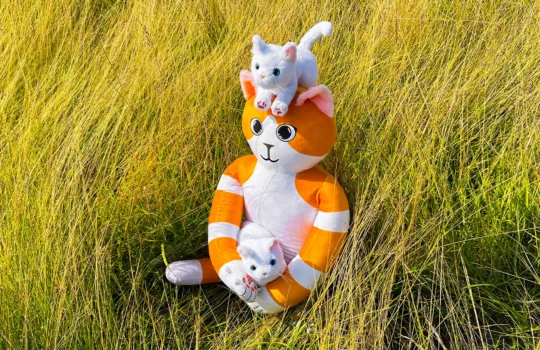Hug Toys: The Power of Holding and Being Held
In today’s fast-paced world, where technology and virtual connections often dominate our lives, the need for physical affection and emotional comfort is often overlooked. However, one simple act of human connection, hugging, has been proven to have profound psychological and physical benefits. Hug toys, a growing trend among both children and adults, embody this comforting act of holding and being held. This article explores the power of hug toys and the therapeutic value they provide in fostering emotional well-being, reducing stress, and enhancing overall quality of life.
The Science Behind Hugs and Emotional Connection
The act of hugging has long been associated with emotional comfort. Research has shown that physical touch, such as hugging, activates the release of oxytocin, a hormone known to promote feelings of trust, safety, and connection. According to a study published in the journal Psychological Science, “Hugging can reduce feelings of loneliness and improve mood, particularly in times of stress” (Holt-Lunstad et al., 2010). The physical touch of a hug, whether from a loved one or a hug toy, signals to the brain that it is safe and cared for, triggering a cascade of positive emotions.
Hug toys are designed to mimic the warmth and security of a human embrace. These soft, often weighted objects provide a sense of comfort and reassurance, which can help alleviate anxiety and promote relaxation. For individuals who struggle with stress or have difficulty forming physical connections, they offer a non-judgmental and accessible solution to enhance emotional well-being.
How Hug Toys Benefit Mental Health
The benefits of hug toys go beyond mere comfort. They have been shown to be a valuable tool in managing stress, anxiety, and even depression. Many people find that hugging a soft, plush object provides a sense of emotional grounding and helps them manage overwhelming feelings. In fact, they are often used in therapeutic settings to support individuals with anxiety disorders, autism, or post-traumatic stress disorder (PTSD).
A study from the National Institutes of Health (NIH) on sensory integration therapy for children with autism suggests that weighted and comforting objects, like hug toys, can help soothe heightened sensory responses and reduce anxiety. These toys can provide a calming effect and act as a sensory anchor, offering a tangible source of comfort when emotions run high. Furthermore, the act of hugging or holding a hug toy can promote a sense of self-soothing, which is crucial for managing emotional regulation.
The Role of Toys in Enhancing Sleep Quality
A lesser-known benefit of hug toys is their ability to improve sleep quality. Many people with anxiety or insomnia have difficulty falling and staying asleep due to racing thoughts and heightened stress. Hug toys, especially those with a gentle weight, create a sensation of being gently held, which can trigger the relaxation response and improve sleep onset. The pressure from these toys is similar to the concept of deep touch pressure (DPT), which has been shown to lower heart rate and reduce cortisol levels, ultimately contributing to a deeper and more restful sleep.
A 2015 study published in the Journal of Sleep Research found that deep touch pressure can have a “calming effect on the autonomic nervous system” and “improve sleep quality in individuals with insomnia” (Field, 2015). Hug toys that provide this type of pressure offer a non-invasive, natural way to improve sleep, especially for those who may be sensitive to pharmaceutical interventions.
Hug for All Ages
While hug toys are often marketed for children, their benefits are not limited to younger audiences. Adults, too, can experience the comfort and emotional support provided by these toys. In fact, many adults turn to hug toys during particularly stressful periods in their lives, such as after a traumatic event, during times of grief, or simply as a means of combating loneliness. Hug toys can serve as an emotional anchor in a world that sometimes feels disconnected and overwhelming.
For children, hug toys play an essential role in emotional development. They can serve as a transitional object, helping children feel secure as they navigate the challenges of growing up. Whether it’s starting school, adjusting to a new environment, or coping with anxiety, a hug toy can offer a familiar and comforting presence.
The Future of Hug Toys
As awareness of mental health and emotional well-being continues to grow, so does the popularity of hug toys. What started as a niche product has now expanded into a thriving industry, with various designs, sizes, and functions available to suit individual needs. Some companies are even incorporating advanced technologies, such as sensors or heat pads, into their hug toys, adding even more layers of comfort and relaxation.
The future of hug toys lies in their ability to adapt to the needs of an increasingly diverse population. As the benefits of physical touch and emotional support become more widely recognized, it’s likely that these toys will continue to evolve, becoming a valuable tool in promoting mental health and emotional resilience for people of all ages.
Conclusion
Hug toys have the potential to provide comfort, reduce stress, and improve mental well-being in ways that go far beyond their soft, plush exterior. Whether used as a therapeutic tool for anxiety, a sleep aid, or simply a source of emotional comfort, the power of holding and being held by a hug toy cannot be underestimated. By understanding the science behind their calming effects and the emotional benefits they provide, it becomes clear that hug toys offer much more than just a comforting cuddle—they offer a path to emotional healing and resilience.

